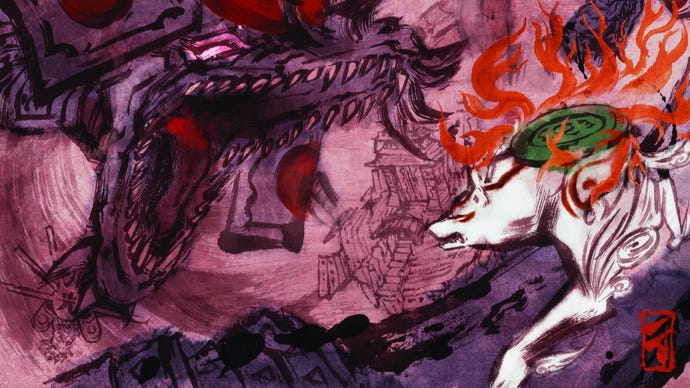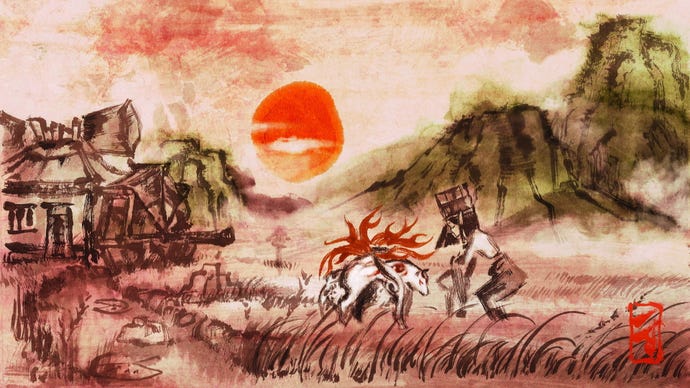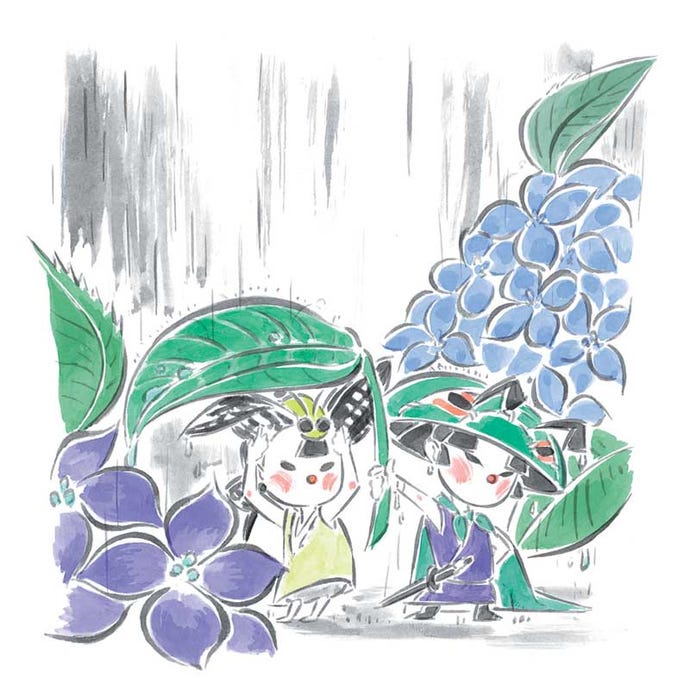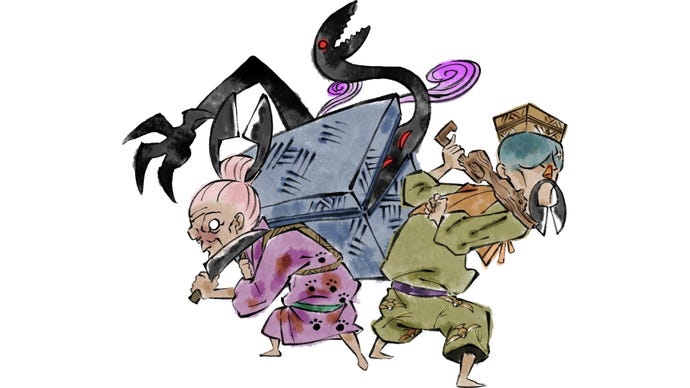The secret myths and folktakes behind Okami
The Wolf Among Us before it was cool
Okami celebrated its 15th anniversary this week, and it got me thinking back to a series of articles I wrote about ten years ago (lawd) about the game's underlying myths and folktales, back when I was all young and pretentious and used phrases like "literary allusion" in posts with a straight face. I know better now (hopefully), but I still look back on that series fondly, and I'd like to share some of those stories here today in honour of the birthday of our favourite sun goddess. You might be surprised just how many characters are drawn from Japanese mythology, because lemme tell ya, Okami pretty much did the whole Wolf Among Us fairytale-characters-all-living-together schtick waaaay before old Bigby was even a speck in Telltale's eye.
Let's start with a nice big obvious one: the tale that defines the entire opening act of the game, the story of Amaterasu, Susano and Orochi. The game feeds off several different versions of this myth, but also gives it a few neat twists of its own.
The legend goes that both Amaterasu and Susano were brought into being by Izanagi, the god of creation, when he went to rescue his wife, Izanami, from the underworld. Like her in-game counterpart, Amaterasu went on to become the Shinto goddess of the sun, while Susano became the god of storms. One day, though, Susano drunkenly murdered one of Ammy's hand maidens, resulting in Ammy sealing herself up in a cave out of fury. Darkness descended on the world (she is the sun goddess, after all), and it was only when the rest of the gods lured her out with a sacred mirror (the "Yata no Kagami") and some divine jewels that the light came back.

Susano, meanwhile, was banished from the heavens and sent to live among the mortals. There, he met an elderly couple whose daughters had nearly all been eaten by the eight-headed monster, Yamata no Orochi. Their last daughter, Kushinada-hime was about to leave as their final sacrifice, but Susano struc a bargain with them: that he could have Kushinada's hand in marriage if he defeated Orochi. To do this, he transformed Kushinada into a comb (natch) to hide her from Orochi and told the couple to brew eight flashes of sake. When Orochi arrived, he just couldn't resist having a quick drink first, and each head ended up drinking an entire flask. With eight hangovers now brewing inside him, Orochi promptly conked out and fell asleep, leaving Susano the perfect opportunity to chop him up into tiny pieces and save the day.
A lot of this will probably be familiar if you've played Okami, but it's the way the story's been interpreted and remixed that I find most fascinating. Susano is still descended from (Iza)Nagi, for example, but both are comparatively helpless in the face of Orochi's might. So are Ammy and Shiranui, the white wolf that once helped Nagi back in the day, and it's only when each pair combine their respective strengths that they're able to take the big dragon down. It also finally explains Ammy's sake battle technique, too!
The reason for Ammy sealing herself up in a cave is different in the game as well. Here, it's the death of Shiranui that causes the light to disappear from the world, and it's from Shiranui's statue that Ammy makes her triumphant return. I mean, she's also been turned into a wolf for the purposes of this story, so anything goes, really, but it does explain the origin of Ammy's iconic weapons - her beloved mirror and, eventually, her Magatama beads.

Ammy's diminutive pal Issun is also a riff on the tale "Issun-boshi" (or One Inch Boy). This tells the tale of a chap no bigger than a man's fingertip who tries to make his fortune as a miniature samurai, wielding a needle as his sword. Despite his tiny size, he manages to rescue a princess from a demon carrying a magic mallet. Issun is gobbled up whole in the process, but a prick of his needle in the monster's stomach causes it to spit him back up, drop his mallet and scarper. As a reward for his bravery, the princess uses the mallet to restore Issun-boshi to his normal size and they both live happily ever after.

Issun still has a keen eye for the ladies in Okami, and the size-changing mallet makes an appearance when Ammy must gain access to the locked down palace in Sei-an City. Similarly, Ammy's pint-sized tour of the emperor's gullet mimics Issun-boshi's descent into the monster, and Issun, we eventually learn, was once a samurai before he set his sights on becoming a painter.
It's not just the central characters that can find their roots in Japanese folklore, though. One of my favourite discoveries in compiling this series was the tale behind the strange Cutter couple in Taka Pass. You know the ones - that evil house in the valley that's weirdly sinister for no reason? Yep, they're based on the tale "Shita-kiri Suzume" (or Tongue Cut Sparrow), which tells of a poor old woodcutter and his greedy wife who take in an injured sparrow one day in the woods. The husband wants to care for the bird, but the wife wants to eat it, and when her husband goes out one day she ends up cutting off the tongue of the sparrow after it eats all of their food.
The sparrow flies home and the old man goes looking for it, eventually stumbling on the sparrow's inn where he's greeted warmly and is allowed to rest. He's given some treasure to take home in a box, and when his wife gets wind of this she tries her luck as well. But because she was a badd'un, her box is full of snakes and deadly monsters, and the shock of finding all these horrible things causes her to trip and fall down the mountain, presumably to her death.

In the game, Mr Cutter gets a bit of a rough bargain here, transformed from a kindly old man into another evil bastard like his wife. But they do capture Chun, the daughter of the head of the neighbouring Sparrow Clan, with the intention of eating her later on, their family name of Cutter references the sparrow's cut tongue in the folk tale. Similarly, the Sparrow Clan do indeed have an inn in Sasa Sanctuary, one of the key locations in the second act of the game, and if you sniff about in the some of the rooms you do actually find a man having a lie down who introduces himself as a hunter who once saved an injured sparrow, harking back to the original kindly old man in the story.
I could go on. There's the story of "Tamano no Mae" that forms the basis of the game's middle arc where Ammy does battle with the dark lord Ninetails and Issun's favourite "busty babe" Rao, and there are also the surrounding tales of Otohime, queen of the Dragonians in the game and daughter of the sea god Ryujin (dragon god) in the myth, and "Taro Urashima", the fisherman who rescues a turtle from children who were torturing it on a beach, that feed into this section of the game as well. I'd probably be here all day if I talked about all these as well (there's a reason why I split the original series into multiple articles), but you can find them all here if you want to find out more about them.

I'll leave you with one final tale, that of "Okikurmi", a historical and mythological Ainu figure. The Ainu are indigenous to northern Japan, originally hailing from what's now Hokkaido, as well as the neighbouring islands of Sakhalin and the Kuril Islands, and several elements of their culture crop up when Ammy goes north to the frozen lands of Kamui. The word 'Kamui' is itself a reference to the Ainu's animist beliefs that everything has a spirit ("kamuy") living inside them (which is also drawn out in the animal headdresses worn by the inhabitants of the island), and the Oina tribe that live there in the game is also named after the Ainu word for short epic poems about the gods.
Okikurmi, meanwhile, is the god who taught the Ainu how to hunt and fish, and he's often portrayed as a divine hero and father to the Ainu people. He goes by several names (Ainurakkur and Ae-oyna-kamuy being the main ones) and he's involved in many heroic feats. But the one pertinent to us is the tale of how he saved the Ainu sun goddess Tokapcup-kamuy (their version of Amaterasu) from an evil owl demon. (Fun fact: on the historical side, Okikurmi is also the Ainu name for the Japanese hero Minamoto no Yoshitune, the latter of which was also the basis for Waka's character, as his childhood nickname was Ushiwakamaru).
In the game, it's the wayward, bloodthirsty Oki who takes on the role of Okikurmi, although here he's very much let his power go to his head. He's still a hero figure among the Oina, but his desire for revenge and his naive belief that he and he alone are enough to defeat the evil owl demons Lechku and Nechku suggests it's him who needs saving rather than Ammy. However, much like Okami's interpretation of Susano's myth right at the beginning of the game, working alone simply isn't enough. Instead, it's only by teaming up that Ammy and Oki are able to defeat Lechku and Nechku, allowing Oki to then go on and become the father figure and teacher the Oina tribe deserve.

Again, this is barely scratching the surface of all the other myths and tales you can find in Okami's final act, including the origin of the Poncle, Issun's miniature brethren, Tuskle, the Oina shaman, and Chikap-kamuy, the owl god who is almost certainly the basis for our pals Lechku and Nechku.
Heck, there are loads more in the rest of the game, too, the most famous of which is probably the tale "Taketori Monogatari" (The Tale Of The Bamboo Cutter), which was recently turned into the astonishingly beautiful film, The Tale Of The Princess Kaguya, by Studio Ghibli. This tells of an old couple of find a baby girl from the Moon Tribe inside a shining bamboo shoot, and both Kaguya and her alleged grandfather Mr Bamboo are in Okami as well.
Kaguya's story is properly fascinating. As well as being one of the earliest examples of science fiction in Japan, some versions of her tale actually have her being sent to Earth in order to save her from a celestial war among the gods, which is exactly what happens over the course of Okami as Ammy works to defeat the evil Yami from destroying the cosmos. Viewed in that light, you could almost say that Kaguya's tale is the real legend behind Okami's spectacular story, with everything taking place in the boundaries of one, big, mythological showdown. Not bad for a tiny shoot of bamboo, eh?









